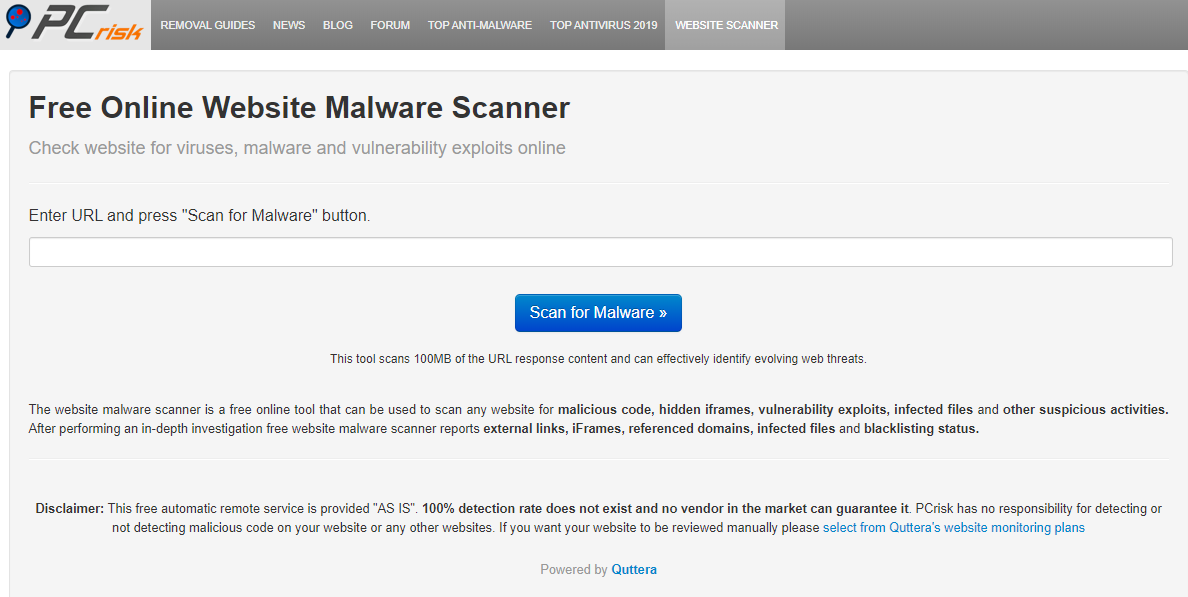
- Url check for malware how to#
- Url check for malware manual#
- Url check for malware code#
- Url check for malware free#
There are four(4) groups arranged in accordance to the level of maliciousness of each detection in group. You can explore the scan report per each accessed file and see what was detected. If it was identified that any unwanted/ compromising actions could be performed with the visitor's web browser during surfing in this web site then such URL will be assigned appropriate threat level according to our threat severity assessment. The malware assessment will contain complete breakdown of all affected pages including the reason for detection by Quttera exploit detection engine.ĭuring the scan of URL all accessible web content is downloaded from the corresponding web address to our server and then it is scanned by Quttera investigation engines. Your request will be sent to our scanning server for further investigation and once it will finish scanning website's files the result will be presented to you. All you need to do is to provide us with a URL (address of web site) that you want to test and press "Scan for Malware" button.
Url check for malware how to#
Remember, knowing how to check URL for malware is the first step to protecting your data from attacks.It is absolutely free.
Url check for malware manual#
You can choose manual or automatic methods to check for malware on your website. Only then can it guarantee advanced protection.Īs cybercrime advances, website owners need to be aggressive about their website’s security. Every precautionary method against malware should keep up with advancing malware types and trends.Īn effective malware scanner should come with an extensive database that records recent and persistent malware threats. Some advanced scanners can remove the malware automatically. Once a website scanner recognizes malware, then the website owner receives alerts immediately. Malware scanners can scan for common malware types like spam, shell scripts, and backdoor files. Such an action will reduce the negative effect of malware on your website and visitors. Scanning your website every day saves you time and protects you from potential infections. This tool can automatically check URL for malware and remove them. A website scanner can come in handy in this case. You will need robust protection to keep up with such criminal activity. Recent studies indicate that cybercriminals have increased their attacks by 16%. Monitoring your website regularly will protect it from malware. Once you master how to inspect your files, source code, and database for changes, you must do so often. You can also use the file manager from your host. Often, experts recommend the use of FTP to search for malware in your files. They come with different levels of effectiveness and complexity. There are various methods of checking for malware in your files manually. If you notice a strange URL, then it could be a sign of a cyberattack. Check for any lines that start with “” and search for strange file names or URLs that show up.
Url check for malware code#
There are two types of features you should look out for when inspecting your source code for malware. You may require knowledge of some of the common syntax that cybercriminals use to ease the process.

Once your web host grants you access to the tool, examine your site for signs of malware. To check URL for malware, you need permission to access a database administration tool. You can also leverage automated malware scanning. What happens if cybercriminals attack your website, and you do not have a clean backup copy? You can use your CMS’s (content management system) code to check URL for malware, and examine your source code, files, and database for signs of malware. Further, knowing the appearance of your website’s clean code helps you identify signs of malware. Such a tool comes with numerous advantages, like helping you restore your data in case of a cyberattack. You can adopt a tool that creates automatic backups. If you own a website, it is critical to backup your content frequently. How to Check a Malware URL - Watch out for Changes In this case, you can examine your website’s code.

If your website has been attacked, you may want to establish the source of the infection. Many of these sites leverage domain blacklisting and antivirus scanners to check URL for malware.

Url check for malware free#
Various sites can scan URLs free of charge. Here is how to go about it.Ī URL scanner is an ideal tool that can help you identify the malware.


 0 kommentar(er)
0 kommentar(er)
